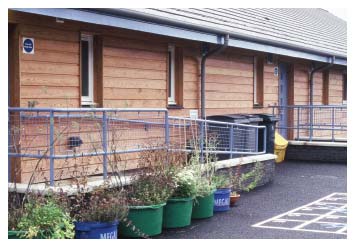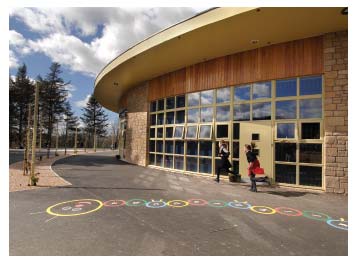Commission on the Delivery of Rural Education: report
The independent commission on the Delivery of Rural Education was established by the Scottish Government and COSLA in July 2011.
This Report makes recommendations on the delivery of all aspects of education in rural areas.
Chapter 3: Educational quality in rural schools
24. The Commission has examined evidence on the delivery of education in rural Scotland, looking in particular to understand whether there were significant issues for schools in rural areas and how to ensure pupils in rural areas received the best possible opportunities.
25. The Commission received evidence from Education Scotland that small rural primary and secondary schools provide a positive educational experience for children and young people. The ability to deliver Curriculum for Excellence was considered specifically. All schools in Scotland face the challenge of providing a curriculum that enables children and young people to build on their prior learning as they move from stage to stage through their school experience. Both Education Scotland's evidence and the Commission's visits to a wide range of rural schools confirmed that this process is more complex in small and very small rural schools where teachers are required to plan for a wider mixed age group in one composite class. Despite these challenges, there is clear evidence that there is no general difficulty in delivering Curriculum for Excellence in rural primary schools, including very small schools, and indeed it can work very well. The Commission noted evidence that rural schools can achieve the highest levels of performance and outcomes, with a number of very small rural schools receiving very positive inspection reports, including the identification of sector-leading practice.
26. Education Scotland did advise that meeting the different learning needs of a range of children at different ages and stages within one class in a very small school is difficult. Evidence from inspections of rural schools demonstrates that HM Inspectors frequently identify this as an area for improvement. In small rural schools where pupil numbers are low, opportunities for children to work collaboratively with peers of a similar age, stage and gender can be limited. Education Scotland's evidence demonstrated that schools are sensitive to these issues and the overall quality of children and young people's experiences is not diminished by these factors.
27. The Commission noted the level of individual attention possible in small schools and how much staff and pupils valued the 'family' atmosphere in these schools. The Commission came across good examples of smaller schools meeting the needs of pupils with additional support needs within mainstream classes and staff noted how much more was possible for these children within small schools. There can be difficulties associated with providing targeted and joined-up support for children and young people with more complex additional support needs in more remote rural areas. Most local authorities and their health colleagues make efforts to overcome any distance barriers to ensure that appropriate specialist support is provided, although in rural settings it can be difficult to draw together the necessary support systems in order to meet the needs of a child or young person fully.
28. There are concerns about a narrowing of the curriculum in the smallest rural secondary schools with difficulty in providing a wide subject choice. As well as the viability of offering subjects which have very low numbers, appointing and maintaining the full range of teachers can be difficult, and mixed level teaching is often required. Suggestions to mitigate some of these issues are made elsewhere in the report. However, this does not detract from the high standards achieved by rural secondary schools. Communities', parents' and pupils' clear choice seems to be for schools to be located in the community, avoiding boarding wherever possible.
Teaching
29. The Commission visited many schools and classrooms in rural areas which were full of engaged and interested young people, committed to their school. Also, during the course of the Commission's visits to rural areas of Scotland, there were many opportunities to speak directly to the teaching and educational professionals who are working to provide the best possible education for children and young people. Many members of staff gave up their evenings to travel to, and contribute to, the Commission's public meetings, and provided a valuable insight into the rural schools in which they worked.
30. The Commission found that there are specific challenges and issues which are particular to teaching in remote areas and the Commission would encourage the many professional bodies and associations related to teaching in Scotland to consider these and how they impact upon the realisation of positive educational outcomes and life chances for children and young people.
Achahoish Primary School (Argyll and Bute)

31. The Commission met some teaching professionals who felt isolated by the rurality of their position. These individuals felt that their access to continuous professional development ( CPD) and to peer interaction was significantly limited. They did not feel that technology could adequately bridge this gap and felt that these limitations could impact upon their ability to teach as well as possible. However, this view was not universal and other teachers in similar situations experienced positive and regular CPD sessions in a 'cluster' group with colleagues from other schools during twilight or weekend sessions. The Commission would encourage all local authorities to consider innovative delivery of CPD to ensure that the effects of isolation are mitigated, including staying abreast of cost effective means to deliver effective CPD and learning from international best practice.
32. Potential routes to the development of appropriate, affordable and locally available CPD for teachers in rural schools should be included in the new arrangements for both career-long professional learning and a Scottish Masters in Education; both currently being developed in response to the recommendations of Teaching Scotland's Future: Report of a Review of Teacher Education in Scotland (2011) 6 . The needs of rural schools, and associated CPD for rural teachers, should be identified and incorporated into the work of the National Implementation Board; the body tasked with ensuring that universities, local authorities and schools address those recommendations and the proposals of Teaching Scotland's Future - National Partnership Group (2012).
33. Headteachers in remote schools often have teaching responsibilities with varying levels of classroom commitment (teaching headteachers) or responsibility for more than one school (shared headships). There are advantages and disadvantages in either approach. The Commission noted that shared headteacher roles allowed councils to attract higher calibre candidates for leadership and provided a clearer career ladder for teachers wanting to stay in rural schools. They also noted that it required a period for a shared headteacher to achieve the alignment between their schools to allow them to work efficiently together and that both the choice of partner schools and of the individuals involved were important factors in making these arrangements work.
34. The absence of a management team around a rural headteacher due to the small size of their school can make their responsibilities particularly isolating; however, many rural headteachers enjoy their varied role and clearly gain great satisfaction from their school. Balancing resources is a key challenge, and the Commission saw examples of choices headteachers were making, for example to reduce their allocated management time and teach classes to save supply costs or allow more to be spent on visiting specialist teachers. Headteachers clearly valued what flexibility they had in order to make solutions work for their school.
35. Teachers and local authorities spoke of the challenges that staff faced in finding affordable accommodation or dealing with the costs of travel in some remote areas. These issues may be a significant deterrent to moving to a remote area where there may be very few other employment opportunities for partners. Given the importance of securing stable staffing arrangements in schools, particularly those with very few teachers, the Commission would encourage local authorities and their partners in the Scottish Government, the teaching trade unions, universities providing teacher education, the General Teaching Council for Scotland ( GTCS) and Education Scotland to explore innovative solutions that reduce the barriers to teaching in remote areas.
36. The Commission was told of difficulty experienced by small remote schools in relation to supply cover, both for sickness and planned absences, and that this added to the pressure on headteachers and staff in rural schools. The Commission was told that recent changes to teachers' pay and conditions which had reduced short-term supply teachers' pay could be a contributory factor to these difficulties. Supply provision in remote rural areas has always been challenging, given that the time and cost of travel to a remote school can deter some supply teachers. However, there is flexibility for local authorities and schools to develop solutions that ensure rural schools have the provision they need and the Commission would encourage innovation in this area.
Nesting Primary School (Shetland Islands)

37. The Commission noted demand for specific training or CPD for teachers wanting to specialise or evidence their proficiency in rural schools, for example, addressing the particular issues of multi-stage teaching required in very small schools. This kind of professional framework might improve recruitment in rural areas and the Commission would encourage local authorities, training providers (including universities), the GTCS and Education Scotland to consider how it could be addressed.
Recommendation 6:
Local authorities, the Scottish Government, teaching institutions and trade unions should work together to explore innovative solutions to reduce the barriers to teaching in remote areas; and to ensure effective delivery of CPD to teachers in rural schools, learning from international best practice to reduce teachers' isolation and sustain skills and development.

Small secondary schools
38. The Commission took a particular interest in small rural secondary schools, and noted the importance these have to the wide areas they serve and the positive attainment levels they achieve. Some small rural secondary schools experience challenges in maintaining a core curriculum, either due to recruitment difficulties or resource constraints. The Commission came across secondary schools struggling, based on following a standard staff to pupil ratio, to maintain a curriculum for their pupils. For example, a school where there was only one teacher covering each of English, German and History, and where Home Economics and Business Studies had been dropped entirely from the curriculum, despite their relevance to tourism which was clearly one of the most significant employment opportunities in the area. The Commission heard evidence from the teachers, families and pupils that this type of situation led to an inequality of opportunity for those young people and would be likely to impact on future employment and higher education prospects. However, in other areas, the Commission noted the extremely high costs per pupil of maintaining very small secondary departments.
39. The Commission was also made aware that primary school teachers could teach S1 and S2 which could be helpful where schools were in sufficient proximity to use a more flexible staffing model. While not acting as a substitute for registered teachers, schools should be encouraged to use a range of expertise in local communities to enhance the experience of pupils. This is explored in more detail in the recent Education Scotland report 'The Involvement of External Experts in School Education'. 7
Denholm Primary School (Scottish Borders)

40. The issues facing very small secondary schools raise the question of when it is acceptable for young people to be required to board to access secondary provision, either from S1 or at later secondary stages. In a few areas, where transport difficulties are insurmountable, this is accepted, but it is clearly very unwelcome in most cases and significantly influences families' decision to live in the area. The Commission heard from communities in Gairloch and Ardnamurchan where secondary schools had been built to prevent children being forced to board away from their families. The young people, their families and wider community members were very clear that they wanted the pupils to stay with their families and communities and that this was beneficial to all.
41. The Commission was concerned that where the decision has been taken to provide secondary education, there must be a commitment to resource such a curriculum to support the achievement of positive outcomes and destinations for young people, and that this will require innovative and flexible arrangements to be developed.
42. The Commission heard from a number of stakeholders that the difficulty in providing a core curriculum was exacerbated by current secondary qualification practices where graduate teachers are encouraged to specialise in one subject only and could only complete a single lead subject during their induction year. It would help small, remote secondary schools if there was the opportunity for teachers to qualify with dual specialisms or if there was support for teachers, where appropriately qualified, to add a second subject/sector to their registration. The Commission recognised that the GTCS has a mechanism in place for adding another subject/sector to their registration through the Framework for Professional Recognition/Registration. However, it requires significant time and in some cases investment from individual teachers. Given the benefits dual qualification can offer both employers and teachers, the Commission suggested that local authorities work in partnership with universities and the GTCS to facilitate and support a streamlined process for teachers who wish to and had the appropriate skills to gain dual qualification. Greater opportunities of this type could provide an incentive to work in rural areas as a teacher, as well as delivering local authorities' duty to provide appropriate CPD for their employees.
43. The Commission recommends that the development of initial teacher education programmes incorporating dual qualification at secondary level (the ability for teachers to be registered to teach two subjects at secondary level) be taken forward with universities offering PGDE Secondary programmes and the GTCS. The Commission also recommends that all initial teacher education programmes provide the necessary learning and skills to understand rural economies and communities and the nature of teaching in rural education settings. Here it is recommended that the GTCS include such a requirement in its accreditation of all new and re-accredited initial teacher education programmes.
Recommendation 7:
There must be a commitment to resource the curriculum in small rural secondary schools to support the achievement of positive outcomes and destinations for young people. This will require innovative and flexible arrangements to be developed including use of local primary school teachers and other experts within the local community.
Recommendation 8:
Local authorities should work in partnership with universities and the General Teaching Council for Scotland to facilitate and support a streamlined process for teachers who have the appropriate skills and wish to gain a dual qualification.
Ardnamurchan High School (Highland)

Broadband
44. It is worth noting that a significant isolating and limiting factor for rural areas is insufficient broadband coverage. All stakeholders were clear that broadband access and other technological advances are not as developed as required in many rural areas and that this has a significant impact on the ability of schools and communities to perform as well as they could; and on the economic opportunities in and viability of these communities. Those remote areas with most need of strong links to broadband provision often had the worst access. Broadband improvement, it was felt, would provide much greater opportunities for otherwise isolated schools, with online learning for pupils and improved CPD opportunities for teachers; as well as the chance to benefit from further innovations likely to develop in the next decade. High quality broadband also significantly supports economic opportunities in rural areas.
Broadband in rural Sweden
Sweden aims to offer world-class broadband provision. The country is similar to Scotland as it covers a large geographical area but has a relatively small population who live predominantly in urban centres. Around 12% of the Swedish population is dispersed in rural areas.
At present, 86% of Swedish households have an internet connection, the highest level of uptake in Europe, and Sweden is the leading country in the EU for the deployment of very high-speed connections. It is estimated that access to wireless broadband is equal between rural and urban areas. However, there are still challenges in accessing fixed broadband in some rural areas in northern Sweden in particular. These areas rely on mobile broadband provision (3G & 4G). Mobile broadband coverage in Sweden's rural areas is 98.8% compared to 88.5% in the UK.
Sweden's geography and population distribution means that broadband coverage in all areas is not commercially viable and public funding supports extending broadband to other areas. Almost 70% of Sweden's municipalities have received some sort of public funding for broadband, pursuing a range of entrepreneurial approaches to support provision in their area. Public sector responsibility for the fibre infrastructure has had a galvanising effect in enabling rural communities to develop their own broadband solutions.
Contact:
digitalscotland@scotland.gsi.gov.uk
45. Commission members found good access to computers in the schools they visited and modern online resources such as Glow were important to the vast majority of these. Glow is currently widely used across Scotland and has provided some useful alternative methods of delivering education. The Commission noted that the facilities available and the active support of teachers also played a key role in how widely and well Glow was used within schools. The Commission is aware that further development of Glow is planned and, if it continues to be developed in line with needs and expectations, would anticipate that its importance and value will increase, in particular for small rural schools.
Nesting Primary School (Shetland Islands)

Contact
There is a problem
Thanks for your feedback